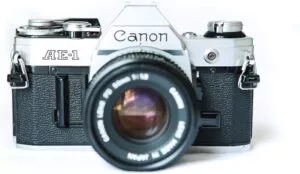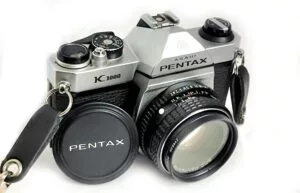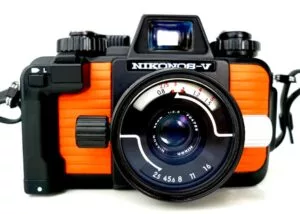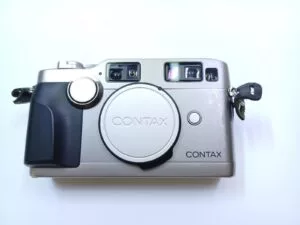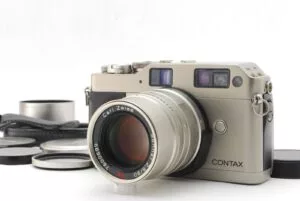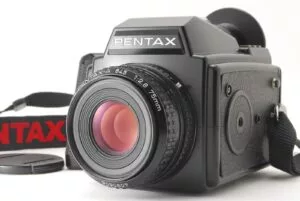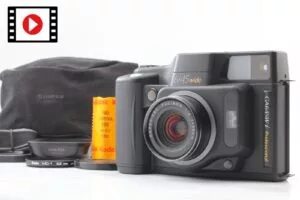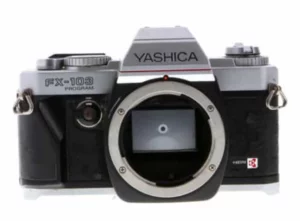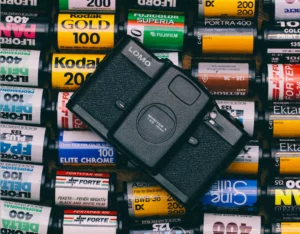
The Best Film Cameras in Canada
With a comeback of the 90s style, old money vibes trending all over social media, and overall nostalgia for traditions, no wonder film cameras joined the trend. As film-related accounts on Instagram are gaining popularity, the demand for film cameras is also rising—thrift stores do not keep vintage cameras for long, and the same applies to eBay and other online retailers.
While DSLR or mirrorless cameras are powerful gadgets for creating sharp images and videos, they also come at a high cost and time-consuming learning process. Not that you can expect high-quality films without basic understandings of composition and exposure, however, film cameras offer simpler operation.
Besides aesthetically pleasing grain and uniquely imperfect pictures, shooting with a film camera teaches you how to slow down and be present in the moment: from choosing the right settings, considering angle, composition and light, to waiting for several days for film development.
At the same time, purchasing a vintage film camera includes the risks of choosing a device with technical issues and other defects that could affect the quality of images. Although we selected some of the best, professional photographers-approved film cameras, we suggest you run some checkups on your camera before buying films and becoming more serious about shooting.
Why Trust Us
If your interest in film photography is based on admiring vintage aesthetics only, and you are just starting, the world of cameras might appear confusing. That is why we combined the best film cameras on the market, and included factors you need to consider when buying a vintage film camera.
Every selected camera was tested by both professional photographers and amateurs (we studied and compared customers’ reviews). Moreover, we analyzed what other buying guides (FieldMag, Petapixel, Digital Camera World) had to say about the best film cameras.
What To Look For in Film Cameras
Where to buy film cameras:
Here comes the real challenge. Even if you know which particular film camera you wish to own, it does not mean that model will be available to purchase at Best Buy or Amazon. (Although Amazon offers a reselling option, hence you might be lucky if someone decides to sell their old film camera.)
Unless you have patience for weekly monitoring of local thrift and antique stores for film cameras, the best way to find what you are looking for is an eBay auction. Another option is to join film photographers’ Facebook groups and track whether one of them sells their old equipment.
You could also try your luck at local camera shops, especially those that offer film development. They might not only be in possession of a selection of film cameras available for sale but also answer any questions you might have about film photography.
Price:
More affordable than DSLR, film cameras still might cost a few hundred dollars. Whilst buying a camera is a one-time payment, you would have to pay for every film roll and development. (Be prepared for a cost of $27 per roll and the same price for developing.)
Negatives:
Whether you are planning an editorial photoshoot, want to capture highlights of your vacation or simply have a film camera on hand for catching little daily moments, there are various types of negatives you could experiment with. From the most popular types such as 35mm, medium and large format, to Instamatic, Kodak disk and rare vintage film rolls, the list keeps going on. Besides choosing the suiting film roll, it is a challenge of finding negatives you want to keep in mind.
One of our managers (while abroad) planned a creative photoshoot using a film camera and CineStill negatives. Considering that the film was unavailable at local stores, he hoped to find CineStill when travelling back to Canada. In Canada, however, no store could help him, (even those that specialize in film cameras). He was losing all hope of completing the photoshoot when a random trip to Urban Outfitters saved the situation. Strangely enough, it was the only place in Edmonton that carried CineStill.
Type of film camera:
As a beginner photographer, you do not need to go further than choosing from three main categories of 35 mm film cameras: point-and-shoot, single lens reflex (SLR) and rangefinder. The first one, a point-and-shoot camera is one of the most popular types, especially among beginner photographers. It is easy to use due to such auto functions as self-timer, flash, loading and rewind.
The SLR film camera is a manual device on which you can adjust ISO, shutter speed and aperture based on the time of day, and outdoor/indoor setting. SLR also allows for more precise composition—looking through the lens provides a better sense of composition and depth of field.
Rangefinders are similar to SLRs: you can easily adjust settings. However, those film cameras only focus on the center of the image, leaving the rest of the composition somewhat faded and blurred. Compared to SLR’s viewfinder, rangefinder cameras use mechanical series of lenses and mirrors. The focus and composition are not as accurate as in SLR cameras simply because the frame lines in the viewfinder do not align with the lens. Yet, the main advantage of the rangefinder is its compact, slender body. That is why most street photographers prefer rangefinder film cameras for their lightweight, small size and quiet operation.
35 mm vs 120 camera:
Two of the most common film formats are 35mm and 120 medium. (Although there are some larger formats, today we are talking about the most user-friendly kinds.)
The main difference between 35mm and 120 film is the size of the film roll. 120 allows for higher resolution and a smoother gradient. If you are planning to print larger-size pictures to frame and hang on the wall, choose medium format film. 120 film format is available in 10, 12 or 16 frames per roll. (220 rolls typically offer twice the length and more exposure.)
35mm film is much smaller, (24mm x 36mm) size and is more common than 120 film format. Those films typically turn out more blurred and grainier.
Understanding the process:
Film photography attracts enthusiasts and professionals not only with its nostalgic grainy images, but also with the anticipation of finding out what you have captured. Remember two main factors when shooting with a film camera. First, you are limited to thirty-six shots. Second, you would have to wait for several days or even weeks for your film to get developed. Hence, careful consideration of choosing what to shoot and patience are two key factors for stunning pictures.
You also want to keep in mind that the very first roll of films does not have to turn out perfectly. However, as you keep trying, experimenting and learning about your camera and photography in general, the better, more precise and profound your shots will turn out.
The Most Dependable Film Camera
Canon AE-1
Introduced in 1976, the Canon AE-1 is a 35 mm workhorse among film cameras: widely used throughout the history of photography, it still remains one of the most reliable cameras worldwide.
Canon AE-1 is one of those cameras that are mass-produced, which makes it easily serviced and affordable. Even if you purchase a second-hand or older version of AE-1 with some technical issues, the chance is high that it could be fixed.
Canon AE-1 is an SLR camera that features all the necessities such as basic settings and compatibility with various interchangeable lenses. Besides programmed settings, the ISO dial (positioned from 25 to 3200 ISO) can be used to calibrate the light meter to match the loaded film. You can set it higher or lower for over- or under-exposed film effects. While it is not necessary if you simply want to capture memorable moments and events, Canon AE-1 still offers enough freedom for experiments. Moreover, such features as “push” or “pull processing” can be especially used for shooting in low-light environments.
Keep in mind here that although the original Canon AE-1 and AE-1 Program are very similar cameras, the latter model was introduced five years later with such upgrades as electronic auto exposure and Shutter Priority mode. That is especially important when you are buying a vintage Canon AE-1 either from the 70s or later decades.
Pros
- Built-in automatic modes.
- Beginner friendly.
- Iconic model.
- Affordable and easily serviced.
Cons
- As per some users, the action is a little slow.
The Best for Film Camera for Beginners
Pentax K-1000
Another entry-level film camera, Pentax K-100 was also released in 1976. Due to its affordability and ease of use, the camera quickly gained popularity among photography enthusiasts.
While there is no automatic operation with Pentax K-100, you would only have to use three controls such as shutter speed (1/100 second), focus and aperture. Beginner users swear that this factor forced them to learn the basics of camera control and photography.
Another advantage of the Pentax K-1000 is the mechanical shutter mechanism. That means the camera does not require batteries to shoot, only SR or LR44 batteries for the metering system. Keep in mind that K-1000 comes with a meter that does not switch off automatically: this feature allows the battery to operate longer without draining it unnecessarily.
Pentax K-1000 also provides you with access to a large catalogue of compatible lenses. Even if you purchase one of the 70s original cameras, you could still try to attach one of the newer autofocus lenses.
Pros
- Ideal for beginners.
- Does not require batteries (expect for the metric system.)
- Mechanical shutter.
- Compatible with a range of lenses.
Cons
- No automatic operation.
The Best Film Camera for Underwater
Nikonos V
Previously in The Best Point-and-Shoot Cameras LINK we have already discussed which cameras you could use to shoot while diving. When it comes to film photography such cameras as Nikonos V can deliver results almost as mesmerizing as the underwater world itself.
Nikonos V 35mm is not an ordinary film camera. Unlike other models, you have to manually operate this camera. One automatic feature it, however, offers, is automatic exposure. Other than that, you are free to switch lenses from the Nikonos series, finding what kind suits your photographic ambitions better. One factor to remember is that Nikonos V requires zone focusing (the technique that uses the lens’ focal plane to shoot in a fast-paced environment), something that certain photographers find useful while others prefer a camera without it.
This camera also features TTL flash control which is a crucial factor to expose images underwater, even at a depth of fifty meters. As per underwater photographers when shooting in salty ocean water make sure to properly clean and lubricate the camera’s O-ring and seals.
Finally, it is the appearance of the Nikonos V that attracts many travelers. The orange rubber finish is not only useful for a proper grip but also offers a stylish retro vibe, think Malibu vacation in the 70s.
Pros
- Automatic aperture.
- Manual exposure controls.
- Waterproof to 50 meters.
Cons
- Depends on where you buy the camera, it might be expensive.
The Best Automatic Rangefinder Film Camera
Contax G2
If previously we spoke of SLR cameras only, Contax G2 is one of the best automatic rangefinders.
The camera features autofocus, auto exposure and auto film rewind. Although it is convenient for beginner photographers, also remember that the camera’s operations are battery controlled. Hence, when you are travelling always have a few extra batteries in your bag.
Surely, Contax G2 is considered a fairly expensive film camera, but as experts say, its Zeiss lenses with a sharp focus and 1/6000th shutter mode, are worth the price. If you are willing to spend even more on your photography gear, try out Contax G interchangeable lenses such as 28mm, 45mm, and 90mm.
Flash is another factor that makes Contax G2 a desirable camera. It does not only work seamlessly but also creates a flash that is not too overpowering.
Pros
- Precise and reliable autofocus.
- Superior lenses.
- Sharp images.
- Easy to use.
Cons
- Viewfinder is smaller than on other cameras.
The Best Bargain Rangefinder Film Camera
Contax G1
Contax G1 features a titanium-clad body, electronically controlled exposure, rangefinder system and autofocus. This particular model uses a viewfinder where “field-of-view changes depending on the lens being used,” as per PetaPixel. Basically, the viewfinder zooms to fill up the entire frame despite the focal length.
Another factor is interchangeable lenses you can experiment with: like other Contax cameras, G1 uses Zeiss lenses that are a worthy competitor of Leika lenses. The Zeiss lenses range from 16mm to 90mm for different types of photography.
Film photography enthusiasts say that a 90mm Sonnar lens is a must-have for anyone who owns Contax G1 or G2. (The lens also adapts to mirrorless cameras; with one exception you would have to buy a ring adapter.)
Pros
- Durable frame.
- Lightweight and sleek.
- Precise and reliable autofocus.
- Superior lenses.
Cons
- Viewfinder is smaller than on other cameras.
The Best Entry Level Medium Format Film Camera
Pentax 645
Pentax 645 is considered one of the best entry-level medium format film cameras. It shoots 120 and 220 films in a convenient image size of 6 cm x 4.5 cm. Photographers say the camera is effective, although fairly simple to use, and affordable, which makes it an ideal choice for beginners.
(You can also look out for newer models such as Pentax 645N, 645NII, 645D, and 645Z. They offer certain upgraded features, which however do not make the original 645 any less good.)
Pentax 645 combines several shooting modes such as Shutter Priority, Aperture Priority, Program and Manual. Besides, its motor advances the film at a 1.5 frame per second, and 16 exposures (120 rolls) or 32 (220 rolls).
The only downside, as per users, is a dark viewfinder. However, many flaws can be forgiven a quality vintage camera.
Pros
- Great ISO performance.
- Easy-to-use system.
- Sharp images.
- Reasonable price.
Cons
- Some users found the camera’s form odd to hold.
The Best Compact Medium Format Film Camera
Fujifilm GA645
One of the best medium format cameras is Fujifilm GA645. Larger than 35mm models, this camera shoots 120 and 220 films and is known for its autofocusing capability and compact size. As many photographers mention, Fujifilm GA645 gets as close to point-and-shoot as possible, but in a film format. (It also features a pop-up built-in flash, which can not be said about most film cameras out there.)
GA645 is one of those film cameras that offers shooting orientation. With this camera, whether you shoot a portrait or landscape you want to hold the device vertically. The final format of images shot in portrait mode, for instance, does not have to be cropped for Instagram.
Among other useful features, you will find Aperture Priority, Program Auto and other manual modes for easy adjustment to any shooting environment. If you already own a point-and-shoot camera, and admire its convenience, you will be pleased with the Fuji GA645 Program Auto feature.
Pros
- Lightweight and durable.
- Superior lenses.
- Built-in pop-up flash.
- Quality old-school design elements.
Cons
- Expensive.
The Ultra-Bargain SLR Film Camera
Yashica FX-103 Program
Yashica FX-103 Program is not an easy-to-find film camera, yet it is one of the favourites among many photographers: if you are lucky you could spot this camera for $100 or less. Despite the low price, the Yashica uses Contax bayonet mount which means you could use several Zaiss lenses and shoot in-depth, stunning pictures. “In fact, some of the lenses were so good that their designs exist to this day in the Zeiss Classic and subsequently the Zeiss Milvus series,” as per PetaPixel.
The FX-103 offers four shooting modes, including Program, High-Speed Program, Manual and Aperture Priority. For this price range, it is an impressive set of shooting modes.
Another feature that is impressive for Yashica is the unusually broad ASA range (12 to 3200).
Pros
- Compatible with Zeiss lenses.
- Four shooting modes.
- Affordable.
Cons
- Hard to find.
Frequently Asked Questions
What are the three types of film cameras?
Film cameras come in three types and are suitable for different purposes: single lens reflection (SLR), rangefinder, and point-and-shoot.
What are film cameras worth?
Since vintage film cameras are not as stable on the market as mirrorless or DSLRs, their price depends on many factors. These could include brand name, model, year of production, overall condition and rarity. Of course, you could spot a film camera for $20 at Goodwill (if you are lucky), but in most cases be ready to pay somewhere between $200 to $600.
Why did people stop using film cameras?
Despite the rising popularity of film photography on Instagram, it is still not the most popular way of taking pictures compared to the 1970s and 1980s.
When in the 1990s digital photography took over, film cameras became obsolete. When smartphones with cameras occupied every pocket, even digital cameras were left to photo and video enthusiasts.
Why does the film look better than digital?
The film is designed to blend light and colour without splitting up linearly. That makes colours look smoother and better blended. Digital cameras, on the contrary, produce images that are exaggeratedly sharp, and often come out with a much lower exposure compared to natural light.
Is film photography making a comeback?
It is impossible not to notice that film photography is making a comeback in social media, wedding photography, and fashion magazines. It offers a certain nostalgic appeal and looks more artsy than digital images, which explains why such a costly and time-consuming way of taking pictures is once again gaining popularity among celebrities, photographers, digital content creators and other enthusiasts.
Read more
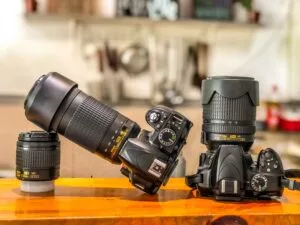
The Best DSLR Cameras in Canada
DSLR cameras let you capture stunning photographs of landscapes, people, wildlife, and many more things.

The Best Ring Lights in Canada
Improve your pictures and videos or simply brighten up your face during a Zoom call with a ring light.

The Best Video Cameras You Can Get in Canada
Vloggers, filmmakers and proud parents who capture every step of their firstborn baby or graduation walk. Find the best video cameras here.
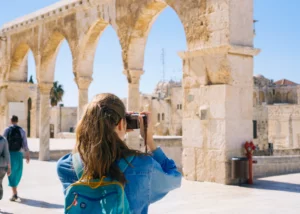
The Best Point-And-Shoot Cameras in Canada
Point-and-shoot cameras are compact, affordable, and capable of taking stunning pictures.
